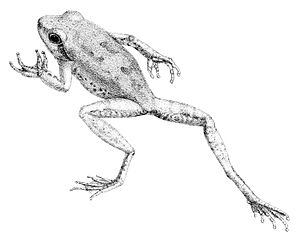Chiromantis petersii facts for kids
Quick facts for kids Chiromantis petersii |
|
|---|---|
 |
|
| Conservation status | |
| Scientific classification | |
| Synonyms | |
|
The Chiromantis petersii is a type of frog that belongs to the Rhacophoridae family. These frogs are often called "foam-nest treefrogs." You can find them in Kenya and Tanzania. They live in many inland areas across both countries.
Another frog, Chiromantis kelleri, used to be thought of as a part of Chiromantis petersii. But now, scientists know it is its own separate species. Both of these frog species live in the same areas in northern Kenya.
Contents
About Peters' Foam-Nest Treefrog
The scientific name petersii honors Wilhelm Peters. He was a German zoologist and explorer. People also call this frog by other names. These include Peters' foam-nest frog or the central foam-nest tree frog.
What Does It Look Like?
Male Chiromantis petersii frogs grow to about 45 millimeters (1.8 inches) long. Females are larger, reaching about 65 millimeters (2.6 inches) long. This measurement is from their snout (nose) to their vent (tail end).
Their backs are usually rough. They are often grey and brown. Sometimes, they have darker marks on their skin. The throat is light in color. It might have small black spots. Their fingers and toes are partly webbed. They also have small, flat pads at the tips of their digits.
How Do They Communicate?
Male frogs make a special sound to attract females. This sound is called an advertisement call. It is a series of quiet creaks.
Where They Live and How They Are Doing
Chiromantis petersii frogs live in dry savanna woodlands. These are areas that usually get less than 800 millimeters (31 inches) of rain each year. You can also find them in farms and even in areas near towns.
Breeding and Nests
These frogs breed in temporary pools of water. They build special foam nests for their eggs. This helps protect the eggs.
Conservation Status
This frog species is quite common and spread out. Scientists believe it is not facing big threats right now. However, in some places, too much animal grazing might affect their homes. Sometimes, these frogs are also kept as pets. They live in several protected areas, which helps keep them safe.
See Also
- African foam-nest tree frog
- Grey foam-nest tree frog
- Chiromantis kelleri


